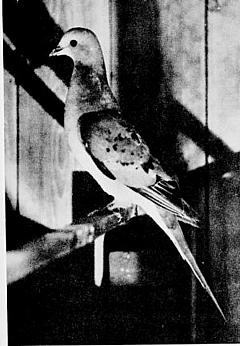Passenger Pigeon
|
|
| Passenger Pigeon Conservation status: Extinct (1914) | ||||||||||||||
|---|---|---|---|---|---|---|---|---|---|---|---|---|---|---|
 An 1898 photograph. | ||||||||||||||
| Scientific classification | ||||||||||||||
| ||||||||||||||
| Binomial name | ||||||||||||||
| Ectopistes migratorius (Linné, 1766) |
The Passenger Pigeon (Ectopistes migratorius) was once probably the most common bird in the world. It is estimated that there were as many as five billion passenger pigeons in the United States. They lived in enormous flocks—the largest of them a mile (1.6 km) wide and 300 miles (500 km) long, taking several days to pass and probably containing two billion birds.
During summer, Passenger Pigeons lived throughout the part of Northern America that is east of the Rocky Mountains. In the winter, they lived in the southern US.
The Passenger Pigeon was a very social bird. It lived in colonies with up to a hundred nests in a single tree, and stretching over hundreds of square miles.
It was hunted for food, for hog feed, and shipped to the cities: in New York in 1805 a brace of pigeons went for two cents. But in the mid-1800s it was noticeable that their numbers were dropping. The passenger pigeon only laid one egg at a time, so once numbers started to decline it would have taken time for them to start rising again. Almost all of the remaining quarter-million Passenger Pigeons were killed in a single day in 1896 by "sport" hunters, who knew they were shooting the last wild flock. The last wild Passenger Pigeon was shot in Ohio in 1900.
The last Passenger Pigeon, named Martha, died in the Cincinnati Zoo on September 1, 1914. She was frozen into a block of ice to be sent to the Smithsonian Institution to be skinned and mounted. She may be seen there today.
See also: Extinct birds.
External link
Songbird Foundation: Passenger Pigeon (http://www.songbird.org/birds/extinct/passpigeon.htm)de:Wandertaube he:יונה נודדת ja:リョコウバト nl:trekduif
